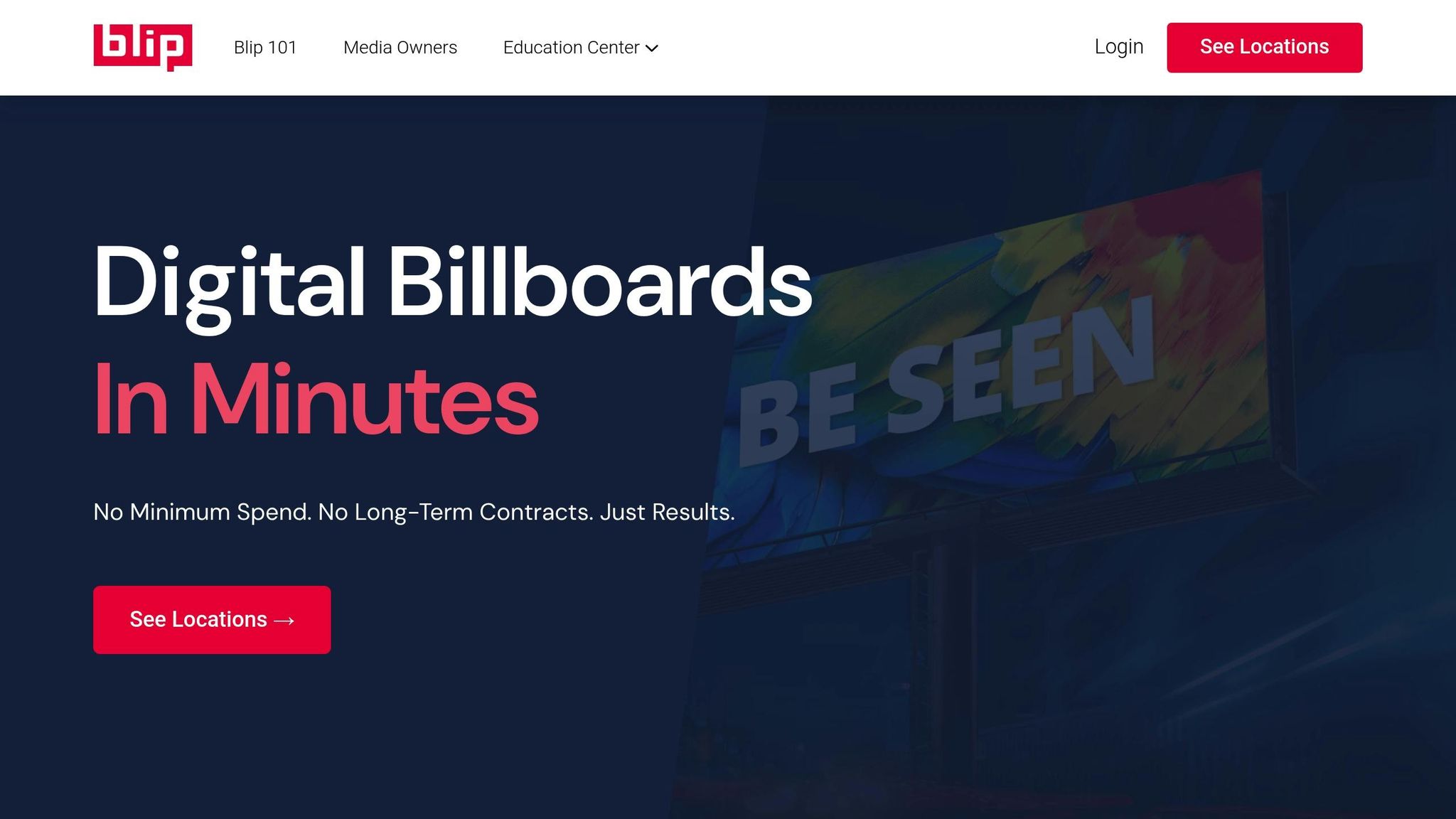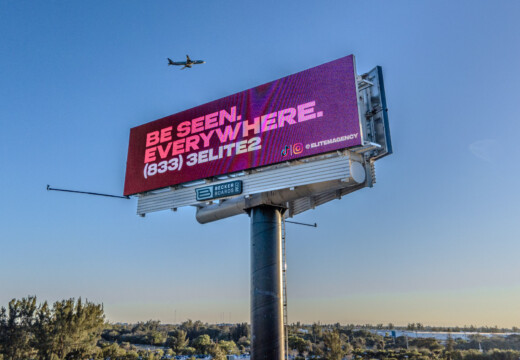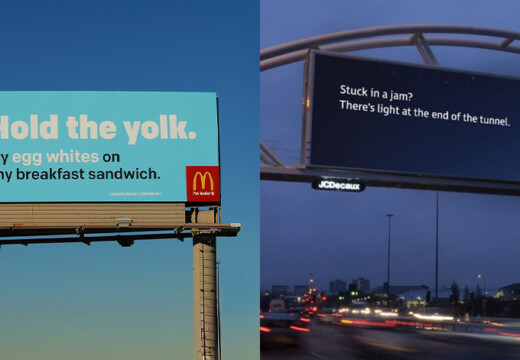Want your billboard advertising to deliver results? Here’s how to make the most of your budget:
- Set Clear Goals: Define what success looks like – brand awareness, store launches, event promotion, or sales growth. Use measurable metrics like impressions, foot traffic, or revenue.
- Align with Your Marketing Plan: Sync billboards with other efforts like social media and email campaigns. Keep your message consistent across platforms and target the right locations.
- Budget Wisely: Break down costs by campaign duration, locations, frequency, and peak hours. Allocate 70% to top-performing spots, 20% to new opportunities, and 10% for testing or emergencies.
- Use Data to Adjust Spending: Monitor daily performance. Shift funds to high-performing locations and pause underperformers.
- Leverage Tools Like Blip: Start with $20/day, use live bidding to secure competitive rates, and track results in real-time.
The takeaway? Focus on planning, tracking, and refining your strategy to boost ROI and make every dollar count.
Outdoor Advertising Investment Plan – Benefits of OOH …
Define Your Campaign Goals
Setting clear and measurable goals is key to making the most of your billboard advertising budget. Chris Leslie, Founder of Leslie Lightcraft Co, puts it simply:
"Big, bold and out there in public – this is the first step to looking big."
Set Clear Success Metrics
Start by identifying specific, measurable goals for your campaign. Here’s how they might look:
| Goal Type | Success Metrics | Timeline |
|---|---|---|
| Brand Awareness | Daily impressions, website traffic | 30–90 days |
| Store Launch | Foot traffic, opening-week sales | 14–30 days |
| Event Promotion | Ticket sales, attendance numbers | 7–30 days |
| Sales Growth | Revenue increase, conversion tracking | 30–60 days |
Once your targets are defined, align your campaign schedule and messaging to maximize the results.
Match Goals to Marketing Plan
To get the best results, integrate your billboard campaign into your broader marketing strategy:
- Campaign timing: Sync billboard ads with other marketing efforts, like social media or email campaigns.
- Message consistency: Ensure your branding and messaging are cohesive across all platforms.
- Geographic targeting: Focus on locations that support your existing marketing activities.
Calculate Budget Requirements
Your goals should guide your spending. Break down your budget by considering factors like duration, coverage, and display frequency. Ray Bowens, Founder of Hashtag-Vape, highlights the value of billboards:
"Billboards are one of the most impactful ways to advertise, and with Blip, you spend a fraction of what you would end up paying elsewhere."
Key budget considerations:
- Campaign duration: How long your ads need to run to achieve results.
- Geographic coverage: The number of areas or locations you want to target.
- Display frequency: How often your ad should appear during the campaign.
- Peak hours: Time slots that align with when your audience is most active.
Use Data to Guide Spending
Once your goals and budgets are set, it’s time to put your money where the data points. Allocate funds to areas that show the best potential for returns. Keep a close eye on how your actual performance stacks up against your targets.
Understand Impression Data
- Filter billboard locations based on daily impression thresholds.
- Compare CPM (cost per thousand impressions) across different spots.
- Identify peak traffic times for each location.
- When available, track viewer demographics to refine targeting.
Keep Tabs on Live Performance
- Check performance metrics daily to stay informed.
- Establish minimum ROI thresholds for each location.
- Pause ads at underperforming spots after 48 hours.
- Track which creative versions deliver the best results and adjust accordingly.
Focus on Top Performers
- Prioritize locations with the lowest CPM rates.
- Redirect budget from underperformers to the top 10% of locations.
- Study performance trends by time and day to optimize placements.
- Increase spending on locations that consistently deliver strong results.
Next, use these insights to fine-tune your distribution strategy for maximum impact.
sbb-itb-2e2e93f
Smart Budget Distribution
Once you’ve pinpointed your top locations, it’s time to fine-tune how you allocate your budget. Here are some practical strategies to get the most out of your ad spend.
Split Your Budget Based on Performance
Focus your resources where they deliver the best results. Here’s a simple breakdown:
- 70% goes to your top-performing locations.
- 20% supports new locations with strong potential.
- 10% is reserved for testing experimental ideas.
Schedule Ads for Maximum Impact
Timing can make or break your campaigns. Plan ad schedules around high-traffic times, like commuter hours (7–9 AM and 4–7 PM). Adjust your messaging to match different times of the day, ramp up spending during peak seasons, and align campaigns with local events to stay relevant.
Set Aside Emergency Funds
Always keep a 10% reserve for unexpected opportunities or challenges. Use this for:
- Flash sales
- Responding to competitors
- Covering events
- Giving extra support to high-performing locations
This approach ensures you’re ready to adapt while staying on track with your overall strategy.
How to Use Blip Effectively

Once you’ve adjusted your budget, Blip’s platform helps you put your advertising plan into action with ease.
Manage Costs with Pay-Per-Play
Start campaigns with as little as $20 per day. You’ll only pay when your ad is displayed, ensuring no money is wasted on unused impressions.
Take Advantage of Live Bidding
Blip updates its bids every 10 minutes, helping you secure competitive rates on busy, high-traffic billboards.
Set Up Campaigns Quickly
- Interactive location picker: Choose billboard spots based on impressions and CPM.
- Design tips: Follow Blip’s guidelines to make your ads stand out.
- Fast approval process: Blip reviews ads within 90 minutes, and billboard owners typically approve them in 1-3 days.
- Real-time analytics: Monitor your campaign’s performance and make adjustments as needed.
With these tools, you can track results and fine-tune your strategy as your campaign runs.
Track and Improve Results
Once your budget is live, focus on tracking performance and making adjustments to get the best results.
Measure Campaign Success
Use Blip’s analytics dashboard to monitor key metrics like daily impressions, play rates for each location, and CPM. These insights will help you understand how your campaign is performing.
Adjust Spending Based on Data
Keep an eye on live performance and reallocate your budget as needed. Shift funds from locations that aren’t performing well to those delivering better results. Take advantage of Blip’s 10-minute bid updates for quick changes. Set aside 10% of your budget for unexpected high-impact opportunities, and use the data you gather to improve future campaigns.
Learn from Past Campaigns
Look back at historical data, including impressions, CPM, and play-rate trends. Use these insights to make smarter decisions about where to allocate your budget and which locations to target next time.
Conclusion
Set clear objectives, leverage data, and make strategic decisions – this approach ensures your billboard investment delivers results. Billboards provide bold, public visibility that’s hard to replicate through digital channels. Staying aligned with your campaign goals and budget is key.
With Blip’s platform, you can start with as little as $20 per day, experiment with locations in real time, and adjust your budget on the fly. Features like real-time bidding and analytics help you manage costs effectively while securing impactful billboard placements on high-traffic roadways.
Focus on planning, tracking, and refining – this process keeps your campaign flexible, boosts ROI, and ensures your budget works hard for you.


